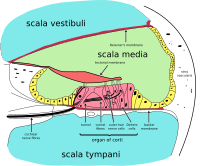
Photo from wikipedia
Moving the head while a sound is playing improves its localization in human listeners, in children and adults, with or without hearing problems. It remains to be ascertained if this… Click to show full abstract
Moving the head while a sound is playing improves its localization in human listeners, in children and adults, with or without hearing problems. It remains to be ascertained if this benefit can also extend to aging adults with hearing-loss, a population in which spatial hearing difficulties are often documented and intervention solutions are scant. Here we examined performance of elderly adults (61–82 years old) with symmetrical or asymmetrical age-related hearing-loss, while they localized sounds with their head fixed or free to move. Using motion-tracking in combination with free-field sound delivery in visual virtual reality, we tested participants in two auditory spatial tasks: front-back discrimination and 3D sound localization in front space. Front-back discrimination was easier for participants with symmetrical compared to asymmetrical hearing-loss, yet both groups reduced their front-back errors when head-movements were allowed. In 3D sound localization, free head-movements reduced errors in the horizontal dimension and in a composite measure that computed errors in 3D space. Errors in 3D space improved for participants with asymmetrical hearing-impairment when the head was free to move. These preliminary findings extend to aging adults with hearing-loss the literature on the advantage of head-movements on sound localization, and suggest that the disparity of auditory cues at the two ears can modulate this benefit. These results point to the possibility of taking advantage of self-regulation strategies and active behavior when promoting spatial hearing skills.
Journal Title: Frontiers in Human Neuroscience
Year Published: 2022
Link to full text (if available)
Share on Social Media: Sign Up to like & get
recommendations!